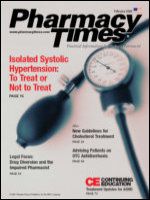Publication
Article
Pharmacy Times
The Role of ACE Inhibitors in Maintaining Proper Blood Pressure
Author(s):
Angiotensin-converting enzyme (ACE) inhibitors, which are used to lower blood pressure and may also help prevent or slow the progression of kidney disease in people with diabetes, are widely prescribed in the United States. The first ACE inhibitor, captopril, was introduced in the United States in 1981, and there are now 10 medications available in the class (Table 1).
With such extensive utilization of ACE inhibitors, pharmacists will encounter many patients on these medications. Up-to-date and pertinent information on ACE inhibitors can facilitate both recommendations to prescribers regarding their appropriate use and counseling to patients prescribed the medication.
Mechanism of Action
The renin-angiotensin-aldos-terone system (RAAS) plays a major physiologic role in the regulation of blood pressure in the human body. Within the RAAS, ACE plays an important role in the production of angiotensin II, allowing for the conversion of the biologically inactive angiotensin I to angiotensin II. Angiotensin II increases blood pressure by its action as a potent vasoconstrictive substance and by stimulating the production of aldosterone, which promotes sodium and water retention in the body. Therefore, a substance that inhibits ACE will decrease the production of angiotensin II and reduce blood pressure. Of note, there are non-ACE pathways that can convert angiotensin I to angiotensin II so ACE inhibitors do not completely halt the production of angiotensin II.1,2
ACE is also involved in the inactivation of bradykinin, a nonapeptide that causes vasodilation by stimulation the production of prostaglandins and nitric oxide. Therefore, by inhibiting ACE, blood pressure is reduced by inhibiting the breakdown of bradykinin and allowing for increased production of vasodilatory substances (Figure 1). 1,2
Indications for UseThere are five FDA-approved indications for the ACE inhibitor class as a whole: hypertension, heart failure, left ventricular dysfunction, post myocardial infarction (MI), and pro-teinuria associated with diabetic nephropathy (Table 2).(3)However, the individual agents within the class have various combinations of these indications. An understanding of the use of ACE inhibitors for each of these conditions is important for the pharmacist.
HypertensionThe Sixth Report of the Joint National Committee on Prevention, Detection, Evaluation, and Treatment of High Blood Pressure (JNC VI) is the most widely utilized hypertension treatment guideline in the United States. JNC VI does not recommend ACE inhibitors as first-line therapy for patients with uncomplicated hypertension. This recommendation is reserved for thi-azide diuretics and beta blockers, because at the time that JNC VI was authored, there was no evidence from prospective, randomized studies that ACE inhibitors decreased cardiovascular morbidity and mortality in this patient population.(4)However, since that time, the results of a trial comparing the effects of an ACE inhibitor to a beta blocker on cardiovascular morbidity and mortality have become available. The Captopril Prevention Project showed no difference between the two medications regarding cardiovascular morbidity and mortality.(5)With these results, future editions of the JNC report may include ACE inhibitors as first-line therapy in uncomplicated hypertensive patients.
ACE inhibitors are recommended as first-line therapy by JNC VI in hypertensive patients with type 1 diabetes mellitus with proteinuria, heart failure, or post-MI patients with systolic dysfunction.(4)In addition to lowering blood pressure, ACE inhibitors also have beneficial effects on left ventricular hypertrophy, another clinical marker of therapy in the hypertensive patient. ACE inhibitors also avoid some of the detrimental metabolic effects of other antihypertensive medications, such as dyslipidemia, glucose intolerance, and hyperinsulinemia.(6,7)Finally, ACE inhibitors may be used in African Americans successfully, although higher doses or combination with a diuretic may be necessary for optimal effect.
Heart FailureACE inhibitors are a standard in the treatment of heart failure. Numerous studies have shown that ACE inhibitors impart a beneficial effect on heart failure patients regarding cardiovascular morbidity and mortality.(8-10)
ACE inhibitor benefits to the patient with heart failure include afterload and preload reduction (via blood pressure lowering), preserving serum potassium levels, and their effects on endothelial function. Overwhelming evidence shows that ACE inhibitors should be utilized in all heart failure patients unless con-traindicated. However, a disturbingly large number of heart failure patients are either not on an ACE inhibitor or they are taking lower than optimal doses. Pharmacists can be an important part of the heart failure health care treatment team. In fact, one recent study showed that outcomes were improved with a clinical pharmacist as a member of a multidisci-plinary heart failure team.(11)
Post MI The beneficial effects of ACE inhibitors in patients with a prior MI are centered on preventing the worsening of ventricular function. These benefits are mediated by some of the same mechanisms as in heart failure (afterload/preload reduction, preservation of potassium, and endothelial function), as well as correcting plas-minogen activator inhibitor-1 activity and antigen levels and left ventricular modeling.(12)Clinical trials evaluating the effects of ACE inhibitors on cardiovascular morbidity and mortality have shown positive outcomes in post-MI patients. Most clinical trials have shown benefit whether the drug was given within 36 hours or more than 3 days after the MI.(13-15)One notable exception was a trial that utilized intravenous enalaprilat within 36 hours of the MI and, therefore, this medication is best avoided based on available evidence.(16)Using an evidence-based medicine approach, captopril, lisino-pril, or ramipril should be used within 36 hours of chest pain and should be continued for 6 weeks. Further treatment is warranted in those patients with continued left ventricular dysfunction after 6 weeks.(12)
Renal DiseaseClinical trials have shown that ACE inhibitors decrease proteinuria in patients with and without diabetes mellitus. These effects have also been shown to be independent of their effects on blood pressure in several studies. In fact, ACE inhibitors have reduced proteinuria in patients with renal disease without hypertension.(17)The inhibition of angiotensin II is a likely mechanism since the substance has numerous deleterious effects on the kidney. Although ACE inhibitors exert a beneficial effect on the kidneys, they may also cause an increase in serum creatinine and renal dysfunction. Based on this, many clinicians do not prescribe these medications in patients with serum creatinine levels above 3 mg/dL.
Adverse Effects / Drug Interactions
ACE inhibitors are generally well tolerated. Table 3 lists some of the common and/or important side effects. Of note, ACE inhibitors can cause dose-dependent hypotension, which is exacerbated in patients with low serum sodium (due to either decreased intake or diuretic usage). Lower starting doses should be utilized in these patients.
ACE inhibitors can also cause a dry, persistent cough. The cause of the cough is believed to be increased levels of prostaglandins or bradykinins and may be bothersome enough to cause discontinuation of the medication. Pharmacists may be the health care practitioner in the best position to discover this adverse effect, since patients may come to the pharmacy in search of a nonpre-scription cough suppressant.
Hyperkalemia may be seen in patients taking an ACE inhibitor. This effect is produced by the decrease in production of aldos-terone and most commonly seen in patients with renal dysfunction or concomitant usage of medications that raise serum potassium (potassium supplements, potassium-sparing diuretics, etc) or salt substitutes. Angioedema has occurred with ACE inhibitor therapy. Although rare, angioedema is a serious hypersensitivity reaction characterized by swelling of the nasopha-rynx and other parts of the face. Although it may occur at any time, angioedema is most common during the first month of therapy.(3)Drug interactions with ACE inhibitors may be drug-specific or across the entire class (Table 4). As an overall view, drug interactions usually involve either enhanced elevation of serum potassium levels or the augmentation/blunting of the antihypertensive effect of the ACE inhibitor.(3)
Patient Counseling Tips
Pharmacists will encounter numerous patients who are prescribed ACE inhibitors. The pharmacist should counsel the patient on the benefits of therapy, discuss adverse effects, and stress the importance of adherence to their regimen and follow-up monitoring (blood pressure measurement, serum potassium levels, urinary albumin levels, etc). Just as important, the pharmacist will also encounter numerous patients who may benefit from an ACE inhibitor but are not prescribed one. Providing pharmaceutical care to these patients by discussing this issue with their physicians may have a tremendous impact on their clinical outcomes.
Newsletter
Stay informed on drug updates, treatment guidelines, and pharmacy practice trends—subscribe to Pharmacy Times for weekly clinical insights.







